
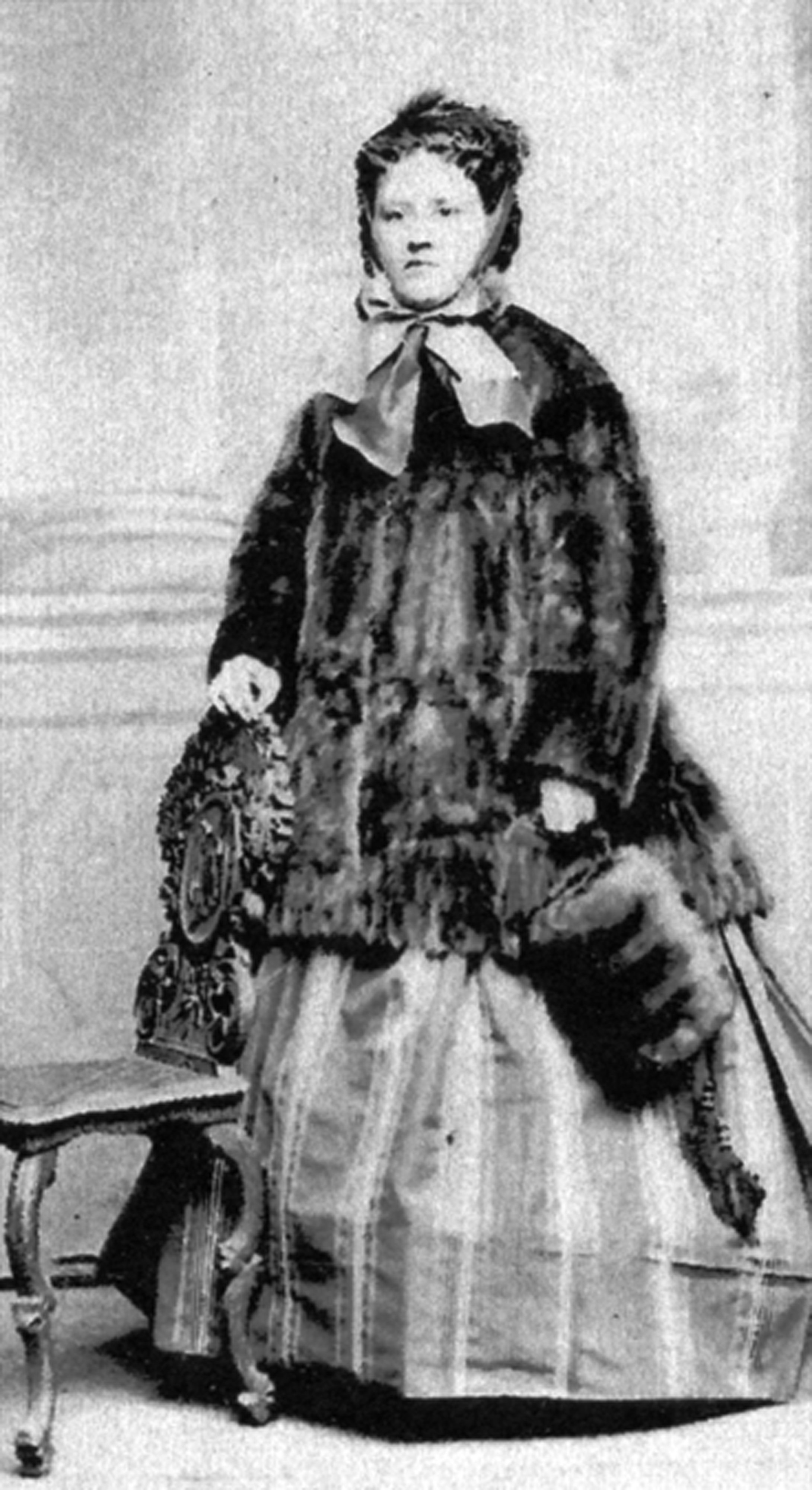
Nina Churchman was born March 26, 1844 in Dubuque, Iowa. The year of her birth is an educated guess. When required to provide a birthdate Nina always uses March 26, but the year ranges from 1838 - 1854. Her obituary claims she was born in 1838 but this is 3 years before her parents marriage. Later in life she wrote an autobiography where she mentions her birthday is March 26 but fails to give a year, as a matter of fact there is not one single date in the entire book.
Little can be found about her parents. Her obituary says James Churchman, was "a prominent lawyer and intimate friend of Abraham Lincoln, both before and after the "Emancipator" became president."1 Nina claimed that as a young lawyer her father rode the Illinois law circuit with Abraham Lincoln and later went to California when the gold rush began but did not strike it rich. She says her mother and brother followed him out there the following year and that she was left with friends. After the family was settled she made the journey by herself by wagon train. When Abraham Lincoln was elected president it is said James went to Washington D.C. to congratulate him and was appointed consul to Valparaiso, Chile. The family accompanied him to Chile and after his term returned to California and then to Nevada where the met and Marcus Larrowe.
Trying to piece all of this together time-wise is a little problem. Lincoln rode the 8th circuit in Illinois between about 1847 and 1854, this would have been after Nina's birth. Nina never says one way or the other whether her father was with Lincoln in her lifetime so it could be true. The Gold Rush to Sacramento started in January of 1848. Perhaps James only rode with Lincoln for about a year. The only time I can place James is with his parents in 1829 at Philadelphia when they are disowned by the Quakers. I then see a record of his marriage to Samantha Miree in 1841 in Dubuque, Iowa. In addition, James Churchman is listed as consul to Valparaiso, Chile between the years 1861 and 1863. It is said the family came back to California after his appointment and then later to Nevada. Nina marries in 1864 so they must have pulled up stakes in California pretty quickly after their return.
Nina said of her life's travels, "I was born in Dubuque, Ia., was taken to Galena, Ill., thence to New Orleans, thence to California and Nevada, then to South America, then to New York city and Europe, back to California and Nevada, to Arizona and New Mexico and then to Portland."1
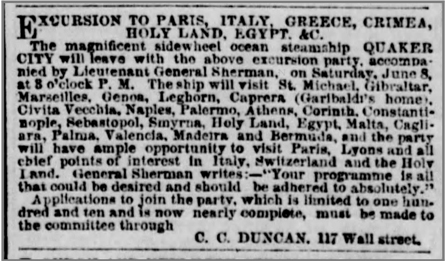
Nina's greatest travel adventure was one taken in 1867. On May 31 she is granted a passport, her husband, M. D. Larrowe, attests that all the facts given are true to the best of his belief. This is the only time I see her claim her birth year is 1844. She is described as 5' 2", with a high forehead, dark brown eyes, medium nose, medium mouth, oval chin, dark brown hair, dark complexion and oval face. The passport is to be delivered to C. C. Duncan at an address on Wall Street. On June 9, 1867, in New York, she boards the steamer "Quaker City" for what is considered to be the first pre-packaged luxury cruise in American history. It was the brainchild of a bankrupt Wall Street shipping magnate, the aforementioned C. C. Duncan. The trip was originally marketed through the Reverend Henry Ward Beecher's (brother to Harriet Beecher Stowe) Plymouth Congregational Church of Brooklyn, where Duncan was a member. The cruise attracted a fundamentally religious, socially conservative, independently wealthy group of travelers. Beecher was supposed to go along but later backed out, it is said that after he backed out tickets got cheaper. The ads state the party is limited to 110, 90 eventually made the trip.
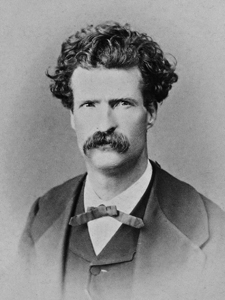
I can't believe it is coincidence that Nina is on this trip with her old acquaintance, Mark Twain but how they came to be together on this trip remains a mystery. We don't know how she felt about the upcoming trip but we do know Twain was certainly looking forward to it,
The steamer arrived back at the port of New York 5 1/2 months later on Nov. 20, 1867. Again, we don't know whether Nina enjoyed herself but we do know that Twain was just a little disappointed.
Twain did write about his adventure and it is said to have been an instant success, within the first year it sold over 70,000 copies and remained the best selling of his books throughout his lifetime,
I can't find any indication of when Marcus and Nina parted ways, they are together in the 1870 census, living at 21 Bank Street in what is now the West Village section of Manhattan. Nina can be found beginning in 1871 in New York city working as an actress using the stage name "Helen Temple." In 1878 a court notice appears in
Nina's obituary references her memoirs, "In New York I had, while never dreaming of having to support myself, taken lessons in elocution of a fine teacher. I also went to Boston one summer and took a course of lessons in gymnastics at Dio Lewis' school. I soon had some knowledge of elocution, gymnastics and stage business but would I, as I intended have the courage to teach them?"1,3 It seems Nina mustered up the courage to trod the boards although in her New York acting career she used the name Helen Temple. A later article referencing her memoirs states "Her first acting job was with a troupe that was so bad and so poorly managed that their performances sometimes drew no one at all. But Nina kept studying, kept working, and eventually, in December of 1872, landed a starring role in a major New York production. She played Joan of Arc in a play called "The Lily of France. The show itself got only a lukewarm reaction but her performance won rave reviews. But unfortunately that show was both the acme and the end of her acting career."4
After reading that I took to the newspaper archives to find some reviews and they do not seem to share the enthusiasm of some.
"Of Miss Ada Ward, who was Cornelia, and Miss Helen Temple, who represented the amorous widow, we can only say that they looked very pretty in very elegant costumes, and there our praise must end."5
"And for Miss Temple to undertake the impersonation of Joan of Arc at Booth's Theatre last night was as bold and perilous a venture as when the simple peasant girl sought the command of the armies of France.....The traditional acting of the "stars" of the sensational drama is not more ridiculous than Miss Temple urging forward her forces on the ramparts of Orleans, and Joan of Arc's contest with Talbot is an episode as goolish as it is unworthy of dramatic art. On a first representation of the piece we cannot speak of it as it may be necessary, for it may improve and at least be worthy of a kinder judgment than can now be accorded. For this reason we pass over anything like a thorough analysis of the play and leave all the minor parts for after consideration, with a single exception. We should be pleased to do the same thing with Miss Temple if we saw any strong hope for her in her profession. She may have genius, but she certainly has not art. A more thoroughly uncultivated actress never undertook a leading part on the New York stage. Her voice is hollow and without a pleasant tone in its entire range, which sometimes reaches even the boisterous. Her acting is scarcely deserving of the name. She has not studied her profession except under the most unfavorable auspices and she brings to the part no peculiar quality except a lack of cultivation, which seems as inherent in the artist as in the heroine. At the same time Miss Temple may improve and become at least a fairly trained actress. The only positive attribute which she envinces is force, and it is upon this that she will have to depend for whatever future progress she may make. The greatest obstacle to success, as we have already indicated, is in her voice, but thorough instruction in elocution may overcome much of the inherent weakness she now exhibits.6" The review goes on to mention a bright spot in the play, "The exception in the acting to which we referred is Mr. George Beck's Court Jester. The clown's conversation with his little white dog was an exquisite bit of acting and it was heartily recognized by the audience."6
A Court Jester with a little white dog in "Joan of Arc?"
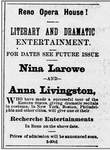
Perhaps after those reviews Nina decided to change her name and ply her trade elsewhere. She dropped an "r" from her last name and once she left New York was for ever after referred to as Mrs. Nina Larowe. The first ads I see for her dramatic recital's is in Reno, Nevada on June 1, 1876. 7
It is said that Nina's aged mother was so scandalized by her daughter's activities that she ordered her back home to California. Her mother died shortly thereafter and Nina hit the "dramatic recital" circuit again. She must not have had a lot of success because on Aug. 1, 1882 Nina got a patronage job at the San Francisco mint based on the political connections of her father. Initially she made canvas sacks for silver dollars for 8c a sack. Later, after a personal friend was appointed head of the mint she was promoted to filing gold blanks down to proper weight to be stamped for coins. In October of 1885 when a Democratic administration came in to power all the Republican patronage employee's were fired.
Once again Nina hits the trail, this time she seems to be centered in Arizona and New Mexico and the venues a little smaller, generally city halls and churches. Within a year she moves to Portland, Oregon where her brother, Ney Churchman, was established as a dentist. She did not, however, want to be dependent upon him and we see her giving dramatic readings in the area. She does not seem to stray too far from Portland and business seems to be falling off. One review says "The reading given by Mrs. Nina Larowe, at the City Barn, on Thursday night of last week, was not a decided success from a financial point, and only moderately so in the way of entertainment. Had it been a burnt cork minstrel show, or something of the "can-can" order the attendance would probably been larger and the applause louder. Those who did attend got their money's worth in the way of very fair renditions of popular pieces, some of which were "elocutionary chestnuts' but good nevertheless. Her character sketch of the backwoods school-girls essay was inimitable and alone worth the price of admission."9The review shown here, from the previous year in Arizona, lists those "elocutionary chestnuts" but like the one quoted above, cites poor attendance.
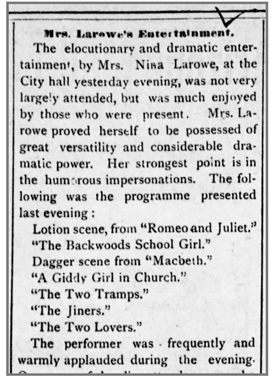
In late 1886, Nina had tried her hand at something other than drama when she gave an exhibition of Dr. Dio Lewis's system of light gymnastics at the local YMCA in Portland. As mentioned earlier she had spent a summer in Boston learning the system. Dr. Diocletian Lewis was a prominent temperance leader and physical culture advocate, and invented the bean bag. He felt the exercises required of athletic young men did not meet the needs of those who most needed the benefit: boys, old, fat or feeble men; and girls and women. This venture was not succesful. She tried offering elocution lessons but that didn't go well either. She did get a job as a society reporter on The Oregonian, but they fired her.
Beginning with the turn of the century we find Nina has reinvented herself as a ballroom dance instructor. The papers are full of notices for dance parties and recitals. She eventually became 'the' dancing mistress for Portland's elite. She rented larger and larger halls to accomodate her growing business and eventually purchased the German Savings and Loan Society's hall, for $6,000.
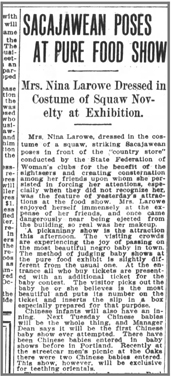 Nina was still occasionally called upon to showcase her acting skills. In September of 1907 she was asked by the State Federation of Women's clubs to entertain at the "Pure Food Show." A local news item read, "Mrs. Nina Larowe Dressed in Costume of Squaw Novelty at Exhibition; Mrs. Nina Larowe, dressed in the costume of a squaw, striking Sacajawean poses in front of the "country store" ....for the benefit of the sightseers and creating consternation among her friends upon whom she persisted in forcing her attentions, especially when they did not recognize her.....so real was her makeup." The paper goes on to list the attractions for the current day, "A pickaninny show is the attraction this afternoon. The visiting crowds are experiencing the joy of passing on the most beautiful negro baby in town." The following Tuesday, "Chinese infants will also have an inning.....This show, will be exclusive for teething orientals."10
Nina was still occasionally called upon to showcase her acting skills. In September of 1907 she was asked by the State Federation of Women's clubs to entertain at the "Pure Food Show." A local news item read, "Mrs. Nina Larowe Dressed in Costume of Squaw Novelty at Exhibition; Mrs. Nina Larowe, dressed in the costume of a squaw, striking Sacajawean poses in front of the "country store" ....for the benefit of the sightseers and creating consternation among her friends upon whom she persisted in forcing her attentions, especially when they did not recognize her.....so real was her makeup." The paper goes on to list the attractions for the current day, "A pickaninny show is the attraction this afternoon. The visiting crowds are experiencing the joy of passing on the most beautiful negro baby in town." The following Tuesday, "Chinese infants will also have an inning.....This show, will be exclusive for teething orientals."10
In 1912 there was a bit of a kerfuffle when Nina and other dancing instructors who owned their own halls, worried about the morals of the youth and attempted to ban unsavory dances. Those dances considered improper included the "Turkey Trot" the "Texas Tommy," the "Grizzly Bear" and "Bunny Hug." Of the Turkey Trot Nina said, "It's like a turkey on a hot plate, constantly lifting its feet so that they won't get burned. When danced in the extreme heads are held very close together - too close together, I should say." The full article can be seen here.
When in her 70's Nina sold her dance hall for, according to her, a handsome profit, enough to keep her in comfort through her old age. The purchaser must not have been able to keep up payments because when Nina wrote her will in 1919, the building was again in her posession.
In about 1917 Nina privately published an account of her life. She titled it, An Account of My Life's Journey So Far: Its Adversity; Its Sunshine and Its Clouds The book was privately printed and undated. It was apparently published and sold to raise funds for the Oregon National Guard unit which was either preparing for or engaged in the First World War. A latter day review for this book, like her New York acting reviews, was less than stellar.
"Individual chapters of this document can be found in the back files of "The Oregonian" where they were originally published. The fact that they were printed there suggests that the paper has higher literary standards now than it did then. Most of the sentences in Nina Larowe's work are difficult and many of the paragraphs simply defy comprehension."4
Nina died, on March 21, 1921, at her apartment in the Multnomah Hotel surrounded by just a few friends. Her brother who had never had children, preceded her in death, dying in 1911. Her estate was appraised at $39,229.12, almost a half-million in 2018 money. The major share of the estate, $25,000 was the value of her dance hall which had been converted into a theater called The Nob Hill. She left the property to the Oregon Humane Society. The only instructions were that the benefits derived go to "the relief of suffering dumb animals." The property and theater were kept in trust for 10 years, with proceeds of $100 a month going to the Humane Society. In 1932 it was turned over entirely to the society. That year it was extensively remodeled with 480 seats, projectors and a big organ. As of 1984 the society still owned the property, and it was still being run as a theater. Nina's obituary can be seen here.
The Nina Larowe building at 2722 NW Kearney St. is located in the Alphabet Historic District of Portland, Oregon and is a feature of the Historic Nob Hill Alphabet District Walking Tour. The brochure lists as a highlight "the tale of the notorious Nina Churchaman (sic) Larowe, the site of one of the largest alcohol raids in Portland history." I contacted Slabtown Tours and was told the raid took place after Nina's death, they did not elaborate on her "notoriety." Might be worth the trip.